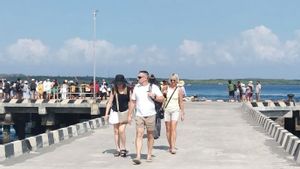JAKARTA - Mirah Sughandi, a local Balinese resident, expressed her disappointment after being kicked out of Sanur Beach by a security guard at the Puri Santrian Hotel on Instagram social media. The video was also viral. Mirah is not the only person affected by the practice of beach privatization. There are still other Mirahs out there. So how does the law regulate it?
The incident took place on the afternoon of Tuesday, March 23. At that time, Mirah admitted that she was kicked out by a hotel security guard when she was playing with her child on the beach, which is located right near the hotel.
"Today I was kicked out by the security guard. He said I could not sit on the beach, it belongs to the hotel. Then I was asked whether the hotel guest was not. Obviously not. I just traveled on this publicly owned beach," Mirah said via her upload.
"This is a very wide beach. I just found out that hotels can have beaches. Seriously I ask, who owns this beach?" asked Mirah continued.
The viral video of Mirah then arrived at the owner of Hotel Puri Santrian, IB Gede Sidharta Putra. He then clarified this. According to him this happened because of miscommunication.
As quoted by Kompas, the hotel said that all beaches are owned by the public. So that any activity may not be prohibited by the hotel. So that this incident did not happen again, he admitted that he would foster his staff.
Mirah is not aloneThis kind of incident is actually not the first time this has happened in Bali. As quoted by CNN, in 2019, a fisherman who was leaning his boat on the coast was suddenly kicked out by a foreign national.
He was expelled because he was said to have entered a private area which was claimed to be part of the villa owned by the foreigner. Strangers are not allowed to go around the beach, let alone leaning on a boat without his permission. The incident also went viral until it led to rejection of the privatization of beaches which often occurs in the Bali region.
Putri Kusuma Sanjiwani in her journal entitled Legal Arrangements for the Privatization of Coastal Borders by Tourism Entrepreneurs in Bali Province (2016) agrees that privatization has occurred in several coastal areas. In Badung Regency, for example, according to Putri's findings five years ago, several beaches that were privatized include Nuda Dua, Seminyak, and Bukit Unggasan.
In addition, Putri also mentioned the areas of Sanur, Canggu and Candi Dasa as coastal areas that were suspected to have been co-opted. "The practice of privatization that is increasingly prevalent in the coastal area of the island of Bali has paralyzed the use and function of the coast as a public area, especially crippling the economy of fishermen."

According to Putri, the privatization was carried out by investors or tourism operators engaged in providing accommodation, including hotels. The form of beach privatization, said Putri, "is in the form of private ownership of an unspoiled (virgin) beach border and a coastal border which is a public facility."
Meanwhile, Mirah also explained the real forms of beach privatization. There is the installation of a barrier in the form of a buoy or flag as has happened in Sanur, the installation of concrete in the beach area to prevent fishermen from sticking their boats as happened in the Candi Dasa area, and the closure of access to the stairs to the beach which is located under the cliff as has happened in the Bukit Jimbaran area.
The rulesBy law, basically this beach privatization has been regulated and prohibited by Presidential Regulation Number 51 of 2016 concerning Coastal Boundaries. The Perpres is derived from Law Number 27 of 2007 concerning Management of Coastal Areas and Small Islands which has been amended to Law Number 1 of 2014.
In detail, the Perpres regulates the matter of coastal boundaries when a person or company builds a building on the coast. The boundary is at least 100 meters long from the highest tide point to the land.
As is well known, coastal boundaries are land areas along the coastline whose width is proportional to the shape and condition of the coast. The border is also the boundary line between the private space of the building and the public space that can be accessed by anyone without the permission of the building owner near the beach.
However, the fact is that the coastal area which has been set to become a border is often co-opted and controlled by building owners such as hotels and villas in the coastal areas. Even though the border itself is not only useful for public activities, but also as an area to maintain the balance of the natural area with humans.
* Read other information about TOURISM or read other interesting articles from Ramdan Febrian.
BERNAS OthersThe English, Chinese, Japanese, Arabic, and French versions are automatically generated by the AI. So there may still be inaccuracies in translating, please always see Indonesian as our main language. (system supported by DigitalSiber.id)










